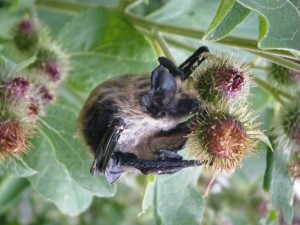Bat Week at ABNC ends Oct 29th

Media release promotes Bat Week and awareness.
The following is from the BC Community Bat Program in honor of Bat Week–Oct 24 – 29.
ABNC still has the Bat Exhibit until Oct 29. If you haven’t seen it, come up and check it out.
Photo: Long-eared Myotis in Burdock. M-Anion
Trick or … a weed pull? Bat-friendly landscaping can help bats at Halloween
As Halloween approaches, images of scary bats become commonplace. This is the perfect time of year to counter bat myths and do something to help bats, by taking part in International Bat Week (October 24-31). Bat Week is all about appreciating these amazing animals and their benefits, including eating insects, pollinating flowers, and spreading seeds and nutrients. Maybe try landscaping that helps bats at Halloween.
This BatWeek, consider bat-friendly gardening to help bats! Planting native trees, shrubs, or flowers in your yard, as well as light-coloured and night-blooming flowers, will support the insects that our BC bats like to eat. Controlling invasive plant species also helps insects and bats thrive, so consider a weed-pull in your yard, laneway, or local park or wetland. You can find more information on bat-friendly gardening through the Community Bat Program’s Bat-friendly Communities Guide at www.bcbats.ca or contact [email protected].
Why BatWeek? “Bats in BC help control agricultural and forest pests, as well as mosquitoes in our yards – but now bats need our help” says Mandy Kellner, Coordinator for the BC Community Bat Program. “Providing safe and healthy habitat for bats has always been important, since over half the species in this province are considered at risk. With the continuing spread of White-nose Syndrome in Washington State, bat conservation is more important than ever as we expect to see impacts in BC in the near future. ”
BatWeek also marks the time of year when bats disappear from our neighbourhoods, until the return of warmer weather in spring. As insect-eaters, our BC bats must leave their summer roost sites and migrate or hibernate to survive the winter. This absence means that this is the time of year to do home renovations that you have delayed due to bat presence. You can clean out and repair a bat box, or do bat-friendly exclusion work, without disturbing or injuring bats.
If you do see a bat in winter, please report it. Monitoring for white-nose syndrome in BC will continue this winter, with Community Bat Programs requesting reports of dead bats or sightings of winter bat activity.
In partnership with the BC Ministry of Environment, and funded by the Habitat Conservation Trust Foundation, Forest Enhancement Society of BC, Habitat Stewardship Program, and local funders, the BC Community Bat Program provides information and promotes local stewardship and citizen science. You can report winter bat sightings, find out more about the BC Community Bat Program, BatWeek activities, and options for helping local bat populations, at www.bcbats.ca, [email protected], or 1-855-922-2287.
Photos:
Long-eared Myotis in Burdock – Removing invasive plants such as burdock allows native plants to thrive and reduces hazards for bats. Photo: M Anion
Bats in a bat box: Bat boxes can provide a secure roost site for bats if properly installed and maintained. Photo: Sunshine Coast Wildlife Project

